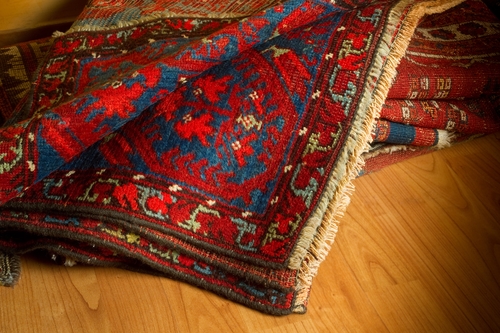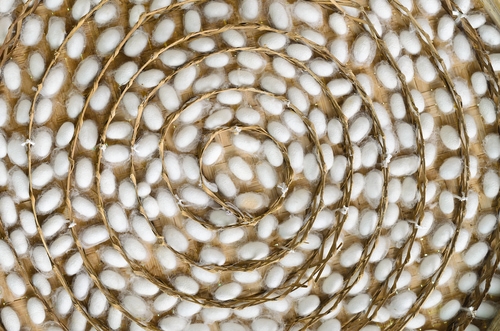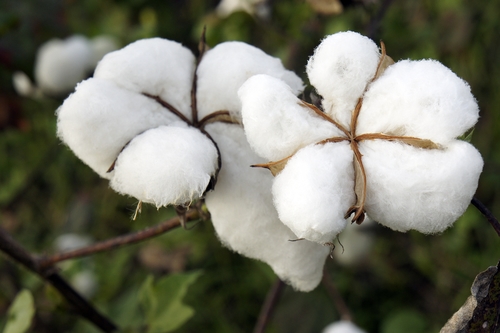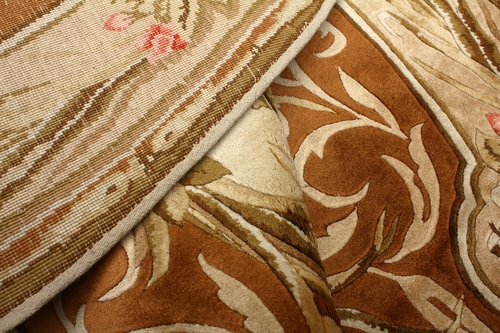Real Silk vs Art Silk Rugs
The luxurious look of an authentic silk rug can be well worth the high price tag that usually comes with it if you are looking for an interesting way to spice up the decor of a room in your home. Unfortunately most people do not have the disposable income needed to purchase one of these high priced rugs and instead opt for an artifical silk rug, also known as art rugs.
Art rugs are typically made either from mercerized cotton or from rayon. Both of these have the same shine and luster as a silk rug but to the trained eye are nowhere near as exquisite or durable as a real silk rug.
In this article you will learn some of the major differences between real and art silk and some quick tests you can do to determine whether you are buying a real silk rug or one made of art silk.
Real Silk Rugs
Real silk rugs are a prized possession for good reason. Silk fibers are very fine and strong allowing for rugs made of silk to have a large amount of knots per square inch (KPSI). Anyone who knows about rugs understands that a high KPSI is a good thing because it allows for more intricate design work and for the rug to be more pliable.
How is real silk produced?
Real silk is produced from the cocoons of silkworms. There are two different production methods, high quality silk from cultivated silkworms and much lower quality silk from wild silkworms:
- Cultivated silk – Silk produced from cultivated silkworms is produced by boiling the cocoons of silkworms with a controlled diet, usually of mulberry, before they become moths. The boiling process allows the entire cocoon to unravel into a single long filament of silk. These filaments are very strong and have a beautiful shine to them which makes it the perfect material for high quality rugs.
- Wild silk – Silk produced from wild silkworms, on the other hand, is produced from worms that are not on a controlled diet and have already broken through their cocoons. As a result, the cocoon will unravel into several filaments of silk which are tied together, creating a much weaker and thicker filament for creating rugs. Rugs created from wild silk are still superior to art silk rugs, however, they are nowhere near the quality of real silk since they have lower durability and have a much lower KPSI.
Mercerized Cotton Rugs
Art silk rugs made from mercerized cotton is the slightly higher quality of faux silk rugs, but still nowhere near the real thing. If you want a rug that looks and feels like a real silk rug but don’t want to make the high investment associated with silk, a mercerized cotton rug is the way to go.
How is mercerized cotton produced?
Mercerisation is a process applied to cotton threads making them stronger and giving them more lustre to have a similar appearance that you would find in silk filaments. Cotton threads are mercerized by stretching them with a controlled tension and treating them with a caustic soda solution. This process swells the cell walls of the cotton fiber giving it’s surface a greater sheen and higher tensile strength.
How does it differ from real silk?
Although the mercerisation process gives cotton a similar look and feel to real silk, it is still lacking in other properties that make silk such an exquisite material for rug production. The fibers are much thicker and thus does not allow for a high knot density, making the rug much less pliable. The thick fibers also make it impossible to create the detailed designs you would find in a real silk rug.
Rayon Rugs
Rayon is another popular choice for producing art silk rugs but of slightly lower quality than mercerized cotton due to its poor durability. This material also has a similar feel and lustre to real silk but to the trained eye it is actually nothing like the luxurious nature of real silk.
How is rayon produced?
Rayon threads are produced by first dissolving cellulose from cotton or wood pulp and turning it into a yellow liquid called viscose, which was given this name due to its high viscosity. The viscose solution is then passed through tiny holes into a chemical mixture the binds the cellulose back together creating long threads that have a similar feel and lustre to silk.
How does it differ from real silk?
Similar to mercerized cotton, rayon has a lustre and smooth feel comparable to silk. Rayon also has similar differences that mercerized cotton has to real silk; the threads are thicker reducing the knot density and pliability of rugs created from the material. Probably the biggest difference between rayon and real silk is the fiber strength. In lab tests, a strand of silk can be bent up to 2,400 times before it breaks while a rayon strand can only be bent 70 times. This makes it a very poor choice for an art silk rug because as it is walked on and the strands get bent, the rayon fibers will quickly deteriorate causing the rug to eventually become visibly damaged.
How to Distinguish Real Silk From Art Silk
Often times, rug vendors try to pass off art silk rugs for real silk, and some of them can be very convincing. Here are some quick tests that you can do to make sure they are telling the truth:
Burn test – Start by taking off a piece of the fringe or pulling out a knot from the back of the rug. All you need is a small piece of the material the rug is made of so that you can put a flame to it. If the ash is hard with a crispy texture and it smells like burning hair, you have yourself a real silk rug. If instead the ash is soft with a chalky texture smelling like burnt paper it is art silk.
- Rub test – Some rug vendors may not allow you to perform the burn test so another test you can do without damaging the rug in any way is the rub test. Simply rub the rug vigorously in your hands. Real silk rugs will become warm when rubbed while an art silk rug will remain cool to the touch.




 Burn test –
Burn test –





